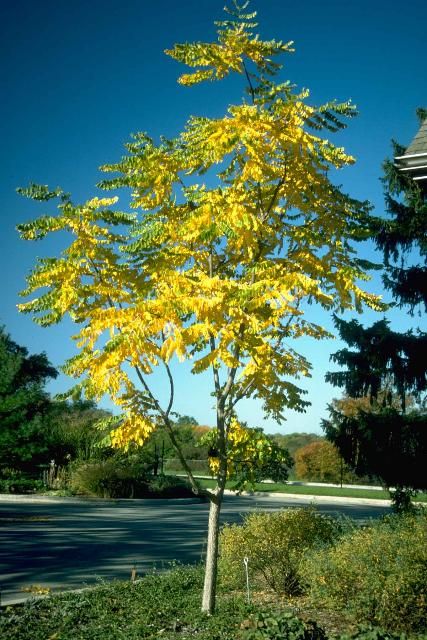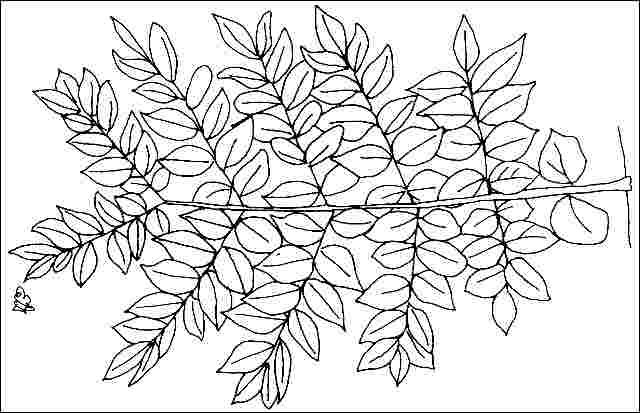Introduction
This is a medium-growing tree that will reach a height of about 70 feet while spreading 45 to 60 feet. The state tree of Kentucky should be used more often because it is adaptable to many soils, including alkaline, has interesting bark and grows with an open canopy allowing light to penetrate to the ground for adequate turf growth beneath the canopy. The coarse branch texture in the winter is also quite unique, forming an interesting silhouette of only several large branches. Large seed pods hang on the tree in the winter but can be a litter problem when they fall in the spring. They are very hard and can be `shot' from a lawnmower running over the fruit. Male trees are sometimes available and they do not set fruit, but this is often unreliable. The seeds (in a 5 to 10-inch-long pod) and leaves may be poisonous to humans. The pod contains seeds which used to be roasted as a coffee substitute. The leaves are bipinnately compound and can be up to 18 inches long, resembling walnut.

Credit: Ed Gilman
General Information
Scientific name: Gymnocladus dioicus
Pronunciation: jim-NOCK-luh-dus dye-oh-EE-kuss
Common name(s): Kentucky Coffeetree
Family: Leguminosae
USDA hardiness zones: 3B through 8B (Fig. 2)
Origin: native to North America
Invasive potential: little invasive potential
Uses: street without sidewalk; reclamation; shade; specimen; highway median
Availability: somewhat available, may have to go out of the region to find the tree

Description
Height: 65 to 70 feet
Spread: 45 to 60 feet
Crown uniformity: irregular
Crown shape: oval
Crown density: open
Growth rate: moderate
Texture: medium
Foliage
Leaf arrangement: alternate (Fig. 3)
Leaf type: bipinnately compound, odd-pinnately compound
Leaf margin: entire
Leaf shape: elliptic (oval), ovate
Leaf venation: pinnate
Leaf type and persistence: deciduous
Leaf blade length: less than 2 inches
Leaf color: green
Fall color: yellow
Fall characteristic: showy

Flower
Flower color: white/cream/gray
Flower characteristics: not showy
Fruit
Fruit shape: pod or pod-like, elongated
Fruit length: 6 to 12 inches, 3 to 6 inches
Fruit covering: dry or hard
Fruit color: green, brown
Fruit characteristics: does not attract wildlife; showy; fruit/leaves a litter problem
Trunk and Branches
Trunk/bark/branches: branches droop; showy; typically one trunk; thorns
Pruning requirement: little required
Breakage: resistant
Current year twig color: brown, green
Current year twig thickness: very thick
Wood specific gravity: unknown
Culture
Light requirement: full sun
Soil tolerances: clay; sand; loam; alkaline; acidic; well-drained
Drought tolerance: high
Aerosol salt tolerance: moderate
Other
Roots: not a problem
Winter interest: yes
Outstanding tree: yes
Ozone sensitivity: sensitive
Verticillium wilt susceptibility: unknown
Pest resistance: free of serious pests and diseases
Use and Management
The trunk normally grows straight up through the crown and is very strong. Branches grow at wide angles to the trunk and are usually well-spaced along the trunk. This configuration adds to the durability of the tree. Be sure that major limbs are kept at less than about half the diameter of the trunk to ensure that they remain well-attached to the tree. The crown is round or oval in youth, becoming more upright and oval with age.
Some people object to the sparse branching when this tree is young, but some pruning to create more branches can help. Any shortcomings of the tree are made up by the almost total lack of insect or disease problems. Lawns grow well beneath the tree due to the light shade cast by the thin, open canopy.
Kentucky Coffeetree is well-adapted to urban soil and could be used more often and, like most trees, does best when provided with irrigation until well-established. Amazingly tolerant of drought and poor soil once established although it is native to rich bottomland soil. Used as a street tree in some communities. Be careful using the tree in a lawn since the pods could become projectiles from mowing equipment.
Male cultivars without fruit should be available soon. These will be well-suited for planting along streets.
Propagation is by seed, or grafting male plants.
Pests and Diseases
No pests or diseases of major concern.